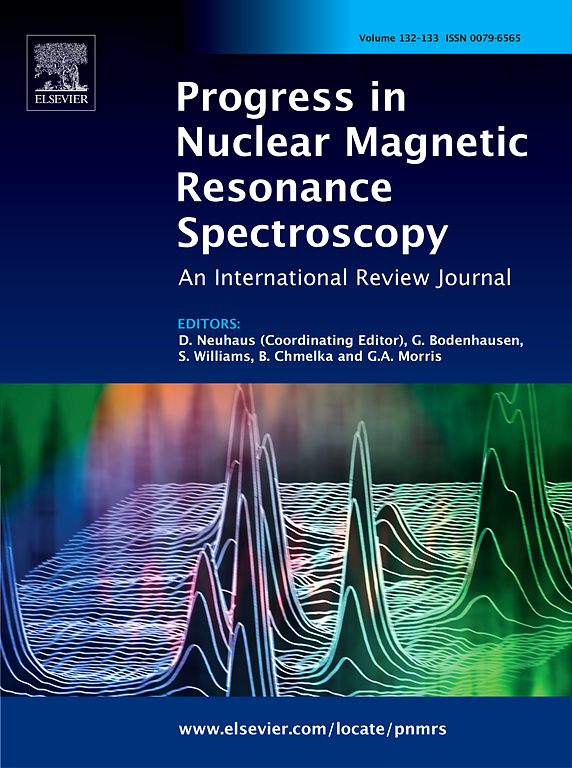基于核磁共振的代谢组学:我们现在在哪里,我们要去哪里?
IF 8.2
2区 化学
Q2 CHEMISTRY, PHYSICAL
Progress in Nuclear Magnetic Resonance Spectroscopy
Pub Date : 2025-04-29
DOI:10.1016/j.pnmrs.2025.101564
引用次数: 0
摘要
快速发展的代谢组学领域侧重于分析生物样品中存在的小分子的复杂混合物。迄今为止,代谢组学已经提供了丰富的生物系统信息,并影响了基础科学和生命科学的许多领域。代谢组学的一个主要焦点是生物医学,其目标是发现生物标志物,发现药物和提高对许多人类疾病发病机制的理解。分析方法在代谢组学中起着举足轻重的作用,其中最广泛使用的两种平台是核磁共振(NMR)光谱和质谱(MS)。在它们的许多互补能力中,核磁共振通常更具可重复性和定量,而质谱更敏感。核磁共振的最新技术进步带来了多方面的发展,包括灵敏度、分辨率和速度的提高,以及代谢物鉴定和定量的扩大,这些都为未来的研究提供了令人兴奋的潜力。除了NMR的发展之外,NMR与MS的结合还提供了许多好处,这些好处随着时间的推移变得越来越明显。因此,代谢组学领域见证了越来越多的研究和应用,将核磁共振与质谱结合在许多领域,包括未知鉴定的新方法开发,代谢物定量,疾病生物标志物的发现,疾病发病机制的理解,以及疾病的饮食危险因素等。本报告描述了基于核磁共振代谢组学的最先进方法的现状,以及最近的进展和未来的前景,重点是核磁共振与质谱结合的好处。本文章由计算机程序翻译,如有差异,请以英文原文为准。

NMR-based metabolomics: Where are we now and where are we going?
The fast-growing field of metabolomics focuses on the analyses of complicated mixtures of small molecules present in biological samples. To date, metabolomics has provided a wealth of information on biological systems and impacted numerous areas of basic and life sciences. A major focus of metabolomics has been on biomedicine with the goal of biomarker discovery, drug discovery and improved mechanistic understanding of the pathogenesis of many human diseases. Analytical methods play a pivotal role in metabolomics, with the two most widely used platforms being nuclear magnetic resonance (NMR) spectroscopy and mass spectrometry (MS). Among their many complementary capabilities, NMR is generally more reproducible and quantitative, whereas MS is more sensitive. Recent technological advances in NMR have resulted in multifaceted developments, including improvements in sensitivity, resolution and speed, along with expanded metabolite identification and quantitation, which together provide exciting potential for future studies. In addition to NMR developments, the combination of NMR with MS provides numerous benefits that are becoming more evident over time. Hence, the metabolomics field has witnessed an increased number of studies and applications that combine NMR with MS in numerous areas, including new methods development for unknown identification, metabolite quantitation, disease biomarker discovery, mechanistic understanding of disease pathogenesis, and dietary risk factors of diseases among others. This report describes the current status of state-of-the-art methods in NMR-based metabolomics, along with recent advances and future prospects, with an emphasis on the benefits of combining NMR with MS.
求助全文
通过发布文献求助,成功后即可免费获取论文全文。
去求助
来源期刊
CiteScore
14.30
自引率
8.20%
发文量
12
审稿时长
62 days
期刊介绍:
Progress in Nuclear Magnetic Resonance Spectroscopy publishes review papers describing research related to the theory and application of NMR spectroscopy. This technique is widely applied in chemistry, physics, biochemistry and materials science, and also in many areas of biology and medicine. The journal publishes review articles covering applications in all of these and in related subjects, as well as in-depth treatments of the fundamental theory of and instrumental developments in NMR spectroscopy.

 求助内容:
求助内容: 应助结果提醒方式:
应助结果提醒方式:


